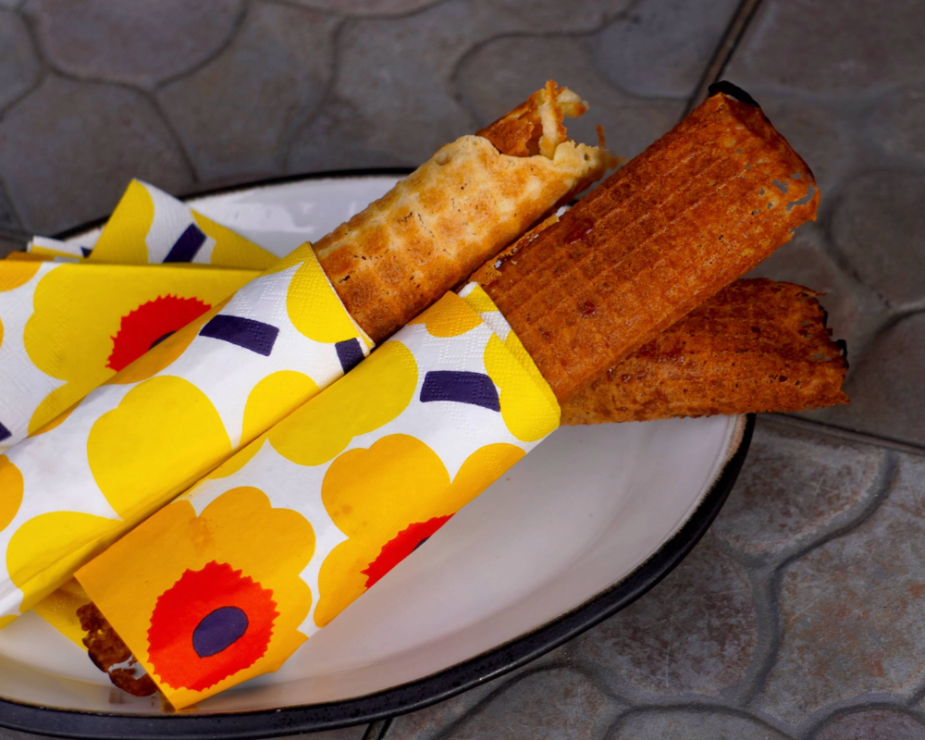
For decades, to eat marquesitas, we had to travel to Mérida, the state capital of Yucatan, and show up after sunset at the Plaza Principal across from the San Idelfonso Cathedral where there was a collection of street vendors. Over propane burners, they heated their two-sided presses of hinged iron slabs, lifted the top plate, poured a small amount of thin batter over the bottom, then closed the 14-inch-wide plates together with a muscled clinch. The two- or three-minute wait to cook each marquesita always seemed interminable. But not until the tissue-thin marquesita was perfectly browned did the marquesita makers open the presses, scatter on some salty Edam cheese or caramely cajeta–or both, if your tastes match mine–and quickly roll up the marquesita before it cooled to shatteringly crisp.
There are fairly well-documented accounts of how Leopoldo Mena began offering marquesitas in Merida back around 1930 at his ice cream shop to boost business during the winter season. (As with all origin stories, all of these facts have been disputed). Soon, as was inevitable, others mastered marquesitas and they became one of the city’s favorite street treats. Besides being impossibly thin so they comically shattered, my favorite version of these pastries celebrates both sweet and salty–salty from the region’s adopted Edam cheese and sweet from cajeta. Originally, it seems, they were made only with the cheese, which seems puzzling to me.
Now, I find marquesita vendors regularly in Oaxaca and Mexico City. I’ve even encountered them in Tijuana, about as far away from Yucatan as you can get and still be in Mexico. The fillings have multiplied along with the number of vendors, most of those offerings sweet. Nutella is one of the new favorites, which I find delicious, along with different fruit jams. Feel free to wander away from the traditional fillings I outline below and explore any that appeal.
If you are really serious, you can buy your own marquesita rig online from Mexican vendors, though I can imagine that shipping costs for such a heavy iron press would be as much as the press itself. Instead, I choose to make marquesitas smaller than the originals using an 8-inch-wide electric or stovetop waffle cone maker. Both are easily available online and will get you to a very satisfying marquesita experience.
INGREDIENTS
- For the batter:
- 1/4 cup vegetable oil
- 1/2 cup milk
- 1 cup flour
- 1/2 cup sugar
- 1/2 teaspoon Mexican vanilla extract
- 1/2 teaspoon Salt
- For the filling:
- About 3/4 cup homemade or store-bought cajeta
- A generous cup shredded Edam cheese (or any other firm, salty cheese that melts a little)
INSTRUCTIONS
Make the batter. Measure all the ingredients into a bowl, along with 6 tablespoons water. Whisk to combine thoroughly and set aside for a few minutes for the flour to hydrate completely. Have your fillings set at the ready.
To cook on an electric waffle-cone maker:
Heat on high for a couple of minutes. Open the irons and spray or brush the top and bottom completely with vegetable oil. Pour ¼ cup of batter in the center of the bottom iron. Press the top down firmly to spread the batter into an even, very thin layer. (Excess batter may come out of the sides–which it does regularly for the well-practiced street vendors. Simply wipe it away with a damp towel or scrape it away with the back of a knife). Cook for 2 to 3 minutes, until the batter is golden and easily comes away from the iron. If things feel stuck, cook a little longer.
For a stovetop 8-inch waffle-cone maker/iron:
Set up a baking sheet next to your burner to keep the oil from flaring up and the batter from making a mess of your stovetop. Heat the iron over medium-low to low on both sides for a couple of minutes. Move the irons onto the sheet, open them and spray or brush the top and bottom completely with vegetable oil. Pour ¼ cup of batter in the center of the bottom iron. Press the top down firmly to spread the batter into an even, very thin layer. (Excess batter may come out of the sides–which it does regularly for the well-practiced street vendors. Simply wipe it away with a damp towel or scrape it away with the back of a knife). Put the iron back over the burner and cook 2 to 3 minutes, flipping it over every 15 to 20 seconds so it cooks evenly. The batter is ready when it is golden and easily comes away from the iron. If things feel stuck, cook a little longer.
Finish the marquesitas. Slide a thin spatula or knife under the marquesita to loosen it. Working very quickly, sprinkle with a portion of the filling(s)--a generous tablespoon of cajeta, a scant 2 tablespoons of shredded cheese. Roll the marquesita into a thin cylinder before it cools to crisp. Serve immediately.




